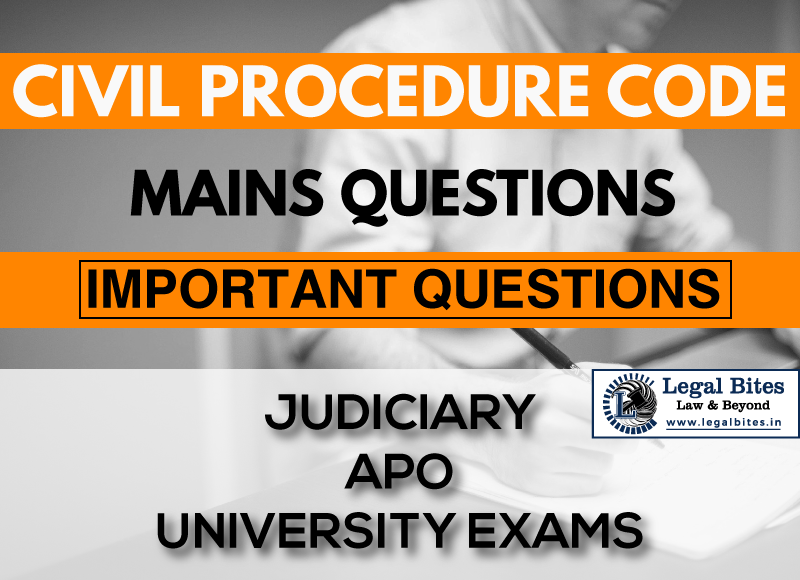'A' advances loan of ₹ 60,000 to 'B'. To bring the suit within the jurisdiction of court, ‘A’ sues 'B' for ₹ 50,000 only instead of ₹ 60,000 and obtains a decree....Decide.
Find the answer to the mains question only on Legal Bites.

Question: 'A' advances loan of ₹ 60,000 to 'B'. To bring the suit within the jurisdiction of court, ‘A’ sues 'B' for ₹ 50,000 only instead of ₹ 60,000 and obtains a decree. Later on ‘A' files a second suit for the balance of ₹ 10,000 in the same court. 'B' raises an objection. Decide. [UPJS 2023]Find the answer to the mains question only on Legal Bites. ['A' advances loan of ₹ 60,000 to 'B'. To bring the suit within the jurisdiction of court, ‘A’ sues 'B' for ₹ 50,000...
Question: 'A' advances loan of ₹ 60,000 to 'B'. To bring the suit within the jurisdiction of court, ‘A’ sues 'B' for ₹ 50,000 only instead of ₹ 60,000 and obtains a decree. Later on ‘A' files a second suit for the balance of ₹ 10,000 in the same court. 'B' raises an objection. Decide. [UPJS 2023]
Find the answer to the mains question only on Legal Bites. ['A' advances loan of ₹ 60,000 to 'B'. To bring the suit within the jurisdiction of court, ‘A’ sues 'B' for ₹ 50,000 only instead of ₹ 60,000 and obtains a decree. Later on ‘A' files a second suit for the balance of ₹ 10,000 in the same court. 'B' raises an objection. Decide.]
Answer
In the scenario described, 'A' advanced a loan of ₹60,000 to 'B' but filed a lawsuit for only ₹50,000 to bring the case within the jurisdiction of a specific court. 'A' obtained a decree for the ₹50,000 amount and later filed a second suit for the remaining ₹10,000 in the same court. 'B' raised an objection regarding this situation.
Under Order II, Rule 2 of the Code of Civil Procedure (CPC), it is explicitly stated that:
"Save as otherwise provided in this rule, a plaintiff may unite in the same suit several causes of action against the same defendant, or the same defendants jointly, and any plaintiffs having causes of action in which they are jointly interested against the same defendant or the same defendants jointly may unite such causes of action in the same suit."
However, the rule further specifies:
"Provided that where a plaintiff omits to sue in respect of, or intentionally relinquishes, any portion of his claim, he shall not afterwards sue in respect of the portion so omitted or relinquished."
In the context of the situation described, 'A' initially filed a suit for ₹50,000 instead of the full amount of ₹60,000, presumably to bring the case within the jurisdiction of the court. 'A' obtained a decree for this reduced amount. Later, 'A' filed a second suit for the remaining ₹10,000.
Considering Order II, Rule 2, it's evident that 'A' omitted to sue for a portion of the claim (the ₹10,000) in the first suit. As per the rule, 'A' cannot subsequently sue for the portion omitted. Therefore, 'B' has a valid objection, and the court should likely uphold it, rejecting the second suit for ₹10,000. 'A' should have pursued the entire claim of ₹60,000 in a single suit initially.
Important Mains Questions Series for Judiciary, APO & University Exams
- CPC Mains Questions Series: Important Questions Part – I of X
- CPC Mains Questions Series: Important Questions Part – II of X
- CPC Mains Questions Series: Important Questions Part – III of X
- CPC Mains Questions Series: Important Questions Part – IV of X
- CPC Mains Questions Series: Important Questions Part – V of X
- CPC Mains Questions Series: Important Questions Part – VI of X
- CPC Mains Questions Series: Important Questions Part – VII of X
- CPC Mains Questions Series: Important Questions Part – VIII of X
- CPC Mains Questions Series: Important Questions Part – IX of X
- CPC Mains Questions Series: Important Questions Part – X of X

Mayank Shekhar
Mayank is an alumnus of the prestigious Faculty of Law, Delhi University. Under his leadership, Legal Bites has been researching and developing resources through blogging, educational resources, competitions, and seminars.
